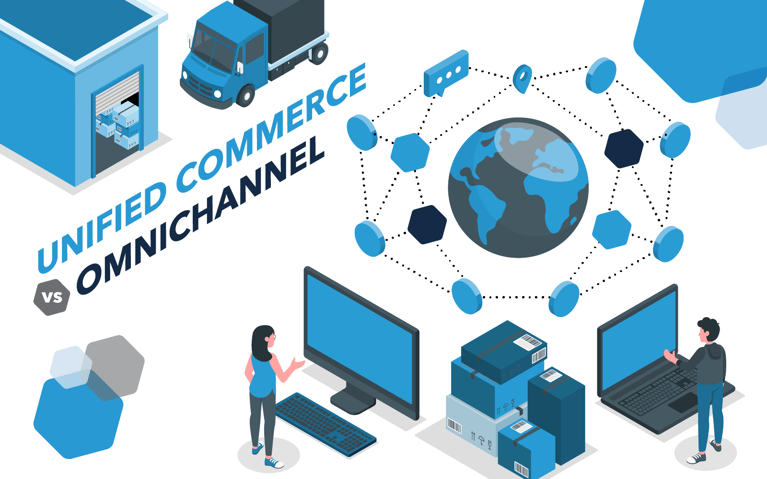Unified commerce is a dynamic, integrated approach to retail that consolidates all sales channels, both online and offline, into a single, cohesive platform. This emerging strategy goes beyond omnichannel commerce and allows businesses to streamline operations, providing a cohesive shopping experience for customers. Unified commerce’s growing importance stems from the increasing consumer expectation for consistency and convenience across all touchpoints, whether they are shopping in-store, online, on marketplaces or through mobile apps. A unified commerce approach improves the customer experience by using real-time inventory visibility, personalized marketing and seamless transitions between different shopping channels.
To attain unified commerce, businesses must invest in the right robust technology solutions. The key is connectivity: Using software that integrates point-of-sale systems, ecommerce platforms and backend operations. Centralization is vital, which might not involve a single solution but rather a highly integrated stack of technologies functioning as one cohesive platform. In essence, it unifies various solutions, replacing fragmented tech stacks that produce disjointed data with a robust, streamlined interconnection. This powerful integration enables real-time data synchronization, providing a holistic view of the customer journey and inventory management. By adopting unified commerce, retailers can meet and exceed customer expectations, driving loyalty and long-term growth.
Unified commerce and the customer experience
Meeting today’s customer expectations requires more than just offering quality products; it necessitates a seamless, consistent experience across all touchpoints. Unified commerce supports the customer experience by integrating various channels – online, in-store, mobile and social – into a single, cohesive platform. This integration ensures that customers enjoy a consistent experience no matter how they choose to interact with the brand. For example, a customer can browse products online, check inventory levels at their local store, make a purchase via a mobile app and then pick up their order in-store, all with seamless transitions. This fluidity not only enhances customer satisfaction but also builds trust and loyalty, as shoppers can rely on the brand to meet their needs effortlessly.
Unified commerce is critical to meeting customer expectations in retail because it eliminates the friction caused by disparate systems. Customers today demand real-time information, personalized interactions and the ability to switch between channels without any hassle. Unified commerce enables retailers to provide these capabilities by consolidating data and operations into a single platform. This consolidation allows for more accurate inventory management, better customer insights and streamlined operations, leading to faster service and more relevant marketing. By adopting a unified commerce approach, retailers can stay ahead of customer expectations, delivering a superior shopping experience that fosters repeat business and positive word-of-mouth.
Your order management system’s critical role in unified commerce
Inventory and order management are critical parts of a unified commerce strategy. Without accurate, real-time information and united systems, challenges and frustrations occur. Let’s say a brand is operating with different systems for their online store versus their physical store and it prevents customers from buying something online and returning it in-store. This can lead to missed opportunities as the customer might have exchanged the item for something else, and potentially even added more to the order. It could also impact the brand’s reputation, forcing the customer to make an unnecessary trip. Today’s customers want flexibility: 56% believe they should be able to return an online purchase at a physical location.
Another common scenario is when an online store shows available inventory at a local location, and a customer buys online to pick it up in-store, only to later receive a notification that the item was not available because inventory didn’t sync quickly enough. This leads to frustration (and a potential Reddit thread about why this happens!).
Your order management system (OMS) is a tech solution designed to integrate and connect your operations, unifying essential data and giving robust visibility to both you and your customers. Here’s how:
Complete omnichannel order and inventory management
An effective order management system provides comprehensive visibility and control over orders and inventory across all channels and locations. It allows businesses to track, route, allocate and modify orders in real-time, ensuring a seamless customer experience regardless of the purchase method. Intelligent order routing and inventory allocation use customizable logic to determine the most efficient fulfillment paths, reducing manual intervention and errors. With robust customer service capabilities, businesses can adjust orders, shipping methods, re-route orders and modify priorities, aligning operations with customer needs. This integration is crucial for managing processes like Buy Online Pick Up In Store (BOPIS) and Buy Online Ship From Store (BOSFS), creating a unified and efficient workflow that enhances customer satisfaction.
Powerful predictive and descriptive insights
A sophisticated order management system leverages AI-driven business intelligence and analytics to provide valuable predictive and descriptive insights. A single intuitive dashboard displays comprehensive data on inventory levels by location, order tracking, and returns across all channels. This capability allows businesses to make informed decisions in real-time, such as changing orders, adjusting shipping methods or re-routing destinations to meet customer expectations. Predictive capabilities support demand forecasting, helping anticipate customer needs and manage inventory more effectively. By delivering these insights, an OMS ensures high levels of customer satisfaction and operational efficiency, enabling businesses to stay ahead of market demands and enhance overall performance.
Save costs with dynamic rate shopping
Effective transportation management within an OMS optimizes shipping costs through dynamic rate shopping features. This allows businesses to secure the best shipping rates across multiple carriers and service levels based on factors like time in transit and cost. The system provides inbound and outbound package tracking, along with order-level shipping analytics and reporting, ensuring cost savings while maintaining high delivery standards. By moving products smarter, faster and more economically, businesses can enhance operational efficiency and reduce costs. This dynamic approach to transportation management is essential for maintaining competitiveness in today’s fast-paced retail environment, ensuring that businesses can deliver on customer expectations while optimizing their logistics operations.
Cart.com is unified commerce
Cart.com helps you attain unified commerce and provide exceptional customer experiences through our innovative services and solutions. Centralize your efforts with Cart.com's OMS and boost connectivity, visibility and efficiency by adding things like our TMS and WMS solutions, and 3PL fulfillment, growth marketing and marketplace services. To learn more about unified commerce, check out our guide to Scaling with Unified Commerce or contact our team today to schedule a demo of Cart.com's OMS.
Subscribe to our emails for the latest industry insights!
By entering your email, you agree to receive marketing emails from Cart.com








